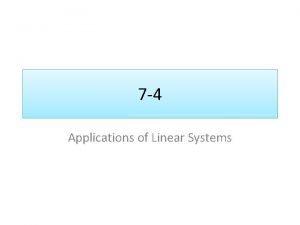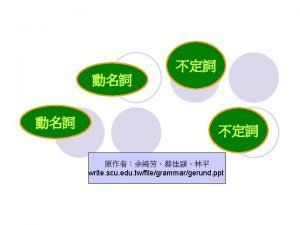when you are young you only want to




























- Slides: 28

…. when you are young you only want to go as fast, as far, and as deep as you can in one subject - all the others are neglected as being relatively uninteresting. But, later on, when you get older, you find that nearly everything is interesting if you go into it deeply enough. – Feynman

Pull thin polymer rod in tension 1 2 4 3 5 Get alignment of crystalline regions

Polymer fibers have aligned crystalline regions - alignment gives greater strength to fiber

Polymer fibers have aligned crystalline regions - alignment gives greater strength to fiber Kevlar is highly aligned

Breaking strength of polymer fibers (tenacity) 1. measure denier (wt. in grams of 9000 meters of fiber) 2. run tensile test

Tenacity also increases w/ chain length - fewer crystal defects

Stress/strain characteristics of polymers Polymer stiffness, strength and toughness vary over extraordinary range

Stress/strain characteristics of polymers Polymer stiffness, strength and toughness vary over extraordinary range Due to structure - ranges from purely amorphous states to chain folded semicrystalline to highly oriented (fibers)

Stress/strain characteristics of polymers Polymer stiffness, strength and toughness vary over extraordinary range Due to structure - ranges from purely amorphous states to chain folded semicrystalline to highly oriented (fibers) Polymers plastically deform readily, esp. if temp raised (often less than 1000 C )

Stress/strain characteristics of polymers Stress (s ) Glassy polymer or semi-crystalline polymer x below Tg Semi-crystalline polymer x above Tg x Rubber Strain (e )

Flexible semicrystalline polymers such as polyethylene (Tg of amorphous domains is below rm temp) usually display considerable amount of yielding if not stretched too quickly Stress Yielding in flexible semi-crystalline polymers Yield Point Strain

Relaxation Yielding due to relaxation Time dependent molecular transition or rearrangement, such as change in conformation of a chain, crystalline slip, chain sliding, usw.

Rigid polymers usually don't have yield point May yield by crazing Stress Yielding in rigid polymers Yield Point Strain

Crazing Microscopic cracks form perpendicular to applied stress

Crazing Microscopic cracks form perpendicular to applied stress Tiny fibrils span cracks - hold material together

Crazing Microscopic cracks form perpendicular to applied stress Tiny fibrils span cracks - hold material together Polymer whitens

Polymers aren’t very stiff

Stiffness dictated by structure

Stiffness depends on crystallinity crosslinking Tg

For fibers, stiffness depends on draw ratio

Tensile strength

Glass transition temperature (Tg)

Glass transition temperature (Tg) Molecular wt.

Glass transition temperature (Tg) Chemical structure

Glass transition temperature (Tg) Chain stiffness

Glass transition temperature (Tg) Chain stiffness

Glass transition temperature (Tg) Bulky side groups

Assignment: Review today's classnotes a. fiber strength b. tenacity c. stiffness d. yielding, relaxation, crazing e. tensile strength f. Tg
 Insidan region jh
Insidan region jh Elements of spoken word poetry
Elements of spoken word poetry This is only for young people
This is only for young people Animal farm chapter 9 and 10
Animal farm chapter 9 and 10 Take only photographs leave only footprints
Take only photographs leave only footprints Don't let anyone look down on you because you are young
Don't let anyone look down on you because you are young If i could only teach you one thing
If i could only teach you one thing Cambios en reported speech
Cambios en reported speech More more more i want more more more more we praise you
More more more i want more more more more we praise you More more more i want more more more more we praise you
More more more i want more more more more we praise you Why do you want to work for us
Why do you want to work for us Unit 5 grammar future time answers
Unit 5 grammar future time answers Unit 5 what do you want to do
Unit 5 what do you want to do So you want to be a social worker
So you want to be a social worker It's everywhere you want to be slogan
It's everywhere you want to be slogan Glittering generalities
Glittering generalities Motivated last thing you want do
Motivated last thing you want do If u want to go fast go alone
If u want to go fast go alone We ______ snowman in winter.
We ______ snowman in winter. Adnan: so you want to become a tennis player?
Adnan: so you want to become a tennis player? Claude cahun what do you want from me
Claude cahun what do you want from me I surrender i want to know you more
I surrender i want to know you more Do you want me to be honest
Do you want me to be honest Suppose you want to combine two types of fruit drink
Suppose you want to combine two types of fruit drink Helen keller overcoming obstacles
Helen keller overcoming obstacles Do you want to be made well
Do you want to be made well Keysuggest
Keysuggest Which country do you want to go
Which country do you want to go We want you
We want you



















































